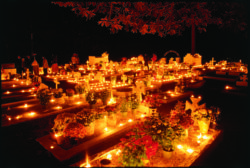Owen F. Murphy Jr.
Owen F. Murphy, Jr. established his standing as one of New Orleans' most respected documentary photographer with his portrayal of Louisiana Creole culture.

Courtesy of Owen Murphy
Osey Ordogne Cemetery, Lacombe, LA. Murphy, Owen (photographer)
A New Orleans native, Owen Murphy, Jr., established his standing as one of the city’s most respected documentary photographers with his portrayal of Louisiana Creole culture. Murphy’s expressive portraits of New Orleans Creoles and depictions of their homes, festivals, workplaces, and neighborhoods are showcased in Creoles of New Orleans: People of Color, published in 1987, with a narrative by Leila Hay Owen. His photographs of Creoles have been shown in many exhibits, including Profiles of a Culture: Louisiana’s Creoles at Jean Laffite National Park and Preserve in Thibodaux, Louisiana; All Saints Day in Lacombe at the International House Hotel in New Orleans; and Louisiana Creoles of Color at the Lafayette Natural History Museum.
Owen Murphy embarked on his photographic career in 1971 (one year after he acquired his first camera), when he sold his first photograph to Rolling Stone magazine. Since that time, he has built a diverse commercial practice, often emphasizing New Orleans musical traditions, while pursuing non-commercial “self-assignments” for personal and artistic reasons. Murphy’s portfolio includes commissioned portraits of such celebrated musicians as Allen Toussaint, Fats Domino, Keith Richards, Bonnie Raitt, and Art Neville, as well as writers Rodger Kamenetz and Moira Crone. During the past four decades, Murphy has been engaged in numerous public activities of the New Orleans photography scene, as both a participant and organizer.
Murphy, who was born September 9, 1948, to Owen and Elsa Perdomo Murphy, was one of a number of photographers who came of age in New Orleans during the late 1960s and early 1970s. Some were natives of the city, others came from elsewhere: Matt Anderson, Luis Castrillo, Sandra Russell Clark, Barry Kaiser, Jack Pickett, Josephine Sacabo, Louis Sahuc, and Michael P. Smith were part of this community. Murphy — who worked initially in black-and-white, 35-mm photography executed in a documentary or journalistic style — found kinship in this group of photographers.
Before establishing his own practice, Murphy worked as a staff photographer for the Vieux Carré Courier (a New Orleans weekly that was often in the thick of political and historic preservation issues) beginning in 1973 and continuing for about three years. Following this journalistic stint, he worked in a number of established commercial New Orleans photographic studios, and was also a specialist in ophthalmic photography. This series of jobs offered Murphy opportunities for perfecting his craft and technique while allowing time to pursue personal projects. One of these focused on the Seventh Ward of New Orleans, and the Creole community that had flourished there for many generations.
Between February and August 1978, Murphy, with the support of a New Orleans Arts Council Grant designed for collaboration of writers and photographers, photographed the neighborhood’s residents, architecture, street scenes, and social life. Another series, Lost Soles — photographs of abandoned footwear — was the subject of a one-person exhibition in 1989 at Loyola University in New Orleans. In 1991, the Louisiana Division of the Arts awarded him a fellowship in photography. Other exhibitions featuring Murphy’s photographs were Moments in Time: New Orleans at the Crossroads, displayed in 2007 at the New Orleans Academy of Fine Arts and the Tarragona International Dixieland Jazz Festival, in Tarragona, Spain, and, that same year, Visions of New Orleans, sponsored by the Ministry of Culture and Communications in Paris, France. Vision/Revision, a show at the Contemporary Arts Center in New Orleans in 2006, included Murphy’s photography.
During the 1990s, Murphy specialized in object photography executed in a studio setting, and often made with a larger format (4×5″) camera on a tripod. A number of museums and galleries relied on his expertise to document their collections for cataloguing and publication purposes, including the New Orleans Museum of Art; the Birmingham Museum of Art in Alabama; the Louisiana State Museum; the Lauren Rogers Museum of Art in Laurel, Mississippi, and the Woldenberg Art Gallery at Tulane University in New Orleans. He provided similar services for work published in auction catalogues. From the 1990s into the twenty-first century, Murphy was on the faculty at the New Orleans Academy of Fine Arts, teaching courses in both introductory and advanced photographic techniques.
Owen Murphy’s work is represented in the holdings of the New Orleans Museum of Art; the Ogden Museum of Southern Art in New Orleans; The Historic New Orleans Collection; the Louisiana State Museum, and the Museum of Fine Arts in Houston, Texas. Commercial clients include a wide range of disciplines, from the Japanese broadcast company NHK and House of Blues Productions to Delta Air Lines, along with a number of museums and galleries.
Murphy acknowledges the changes to his life and career brought on by Hurricane Katrina. Damage to his studio prompted a shift from film-based photography to digitally based imaging. A grant from the Joe W. and Dorothy Dorsett Brown Foundation in 2006 assisted in this transition by providing funds needed to replace damaged equipment. In addition to his continued interest in aspects of Louisiana’s Creole culture, Murphy sees the documentation of New Orleans as it rebuilds after widespread flooding and wind damage as a central theme of his work.
Murphy was involved in the selection of photographs for the exhibition Forty Days and Forty Nights mounted at the Louisiana State Archives in 2008, which focused on the role artists have played in the post-Katrina recovery of southeast Louisiana. In 2006, Murphy was one of the founders of the New Orleans Photo Alliance, a non-profit organization centered in New Orleans and dedicated to exhibition and educational opportunities for photographers throughout the country. He continues to be active in that organization, and in PhotoNOLA, its annual December program of exhibitions, workshops, and lectures.
